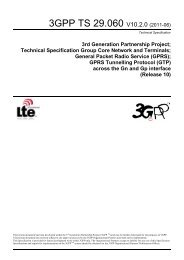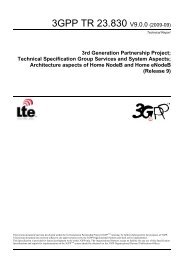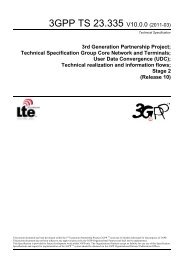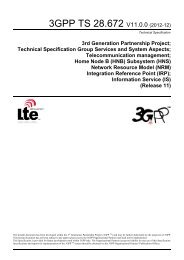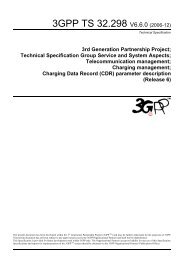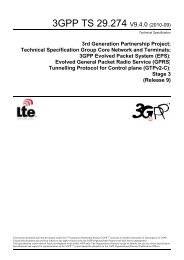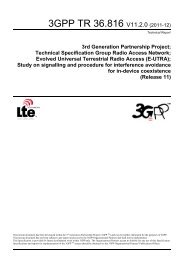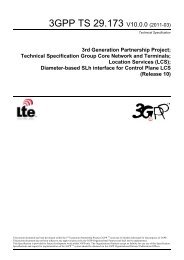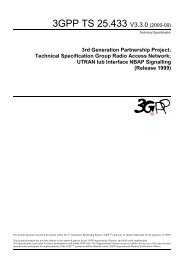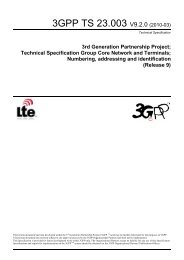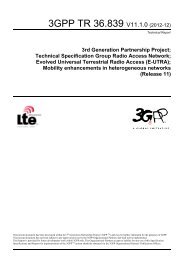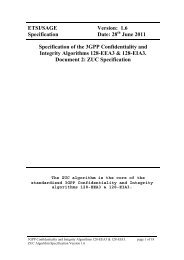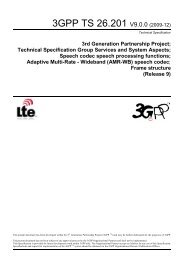UEA2 and UIA2 Specification
UEA2 and UIA2 Specification
UEA2 and UIA2 Specification
You also want an ePaper? Increase the reach of your titles
YUMPU automatically turns print PDFs into web optimized ePapers that Google loves.
ETSI/SAGE<br />
<strong>Specification</strong><br />
Version: 1.1<br />
Date: 6 th September 2006<br />
<strong>Specification</strong> of the 3GPP Confidentiality <strong>and</strong><br />
Integrity Algorithms <strong>UEA2</strong> & <strong>UIA2</strong>.<br />
Document 1: <strong>UEA2</strong> <strong>and</strong> <strong>UIA2</strong> <strong>Specification</strong><br />
3GPP Confidentiality <strong>and</strong> Integrity Algorithms <strong>UEA2</strong>&<strong>UIA2</strong> page 1 of 27<br />
<strong>UEA2</strong> <strong>and</strong> <strong>UIA2</strong> <strong>Specification</strong> Version 1.1
Document History<br />
V1.0 10 th January 2006 Publication<br />
V1.1 6 th September 2006 No change to the algorithm specification at all, just<br />
removal of an unwanted page header<br />
3GPP Confidentiality <strong>and</strong> Integrity Algorithms <strong>UEA2</strong>&<strong>UIA2</strong> page 2 of 27<br />
<strong>UEA2</strong> <strong>and</strong> <strong>UIA2</strong> <strong>Specification</strong> Version 1.1
PREFACE<br />
This specification has been prepared by the 3GPP Task Force, <strong>and</strong> gives a detailed<br />
specification of the 3GPP confidentiality algorithm <strong>UEA2</strong> <strong>and</strong> the 3GPP integrity algorithm<br />
<strong>UIA2</strong>.<br />
This document is the first of four, which between them form the entire specification of 3GPP<br />
Confidentiality <strong>and</strong> Integrity Algorithms:<br />
• <strong>Specification</strong> of the 3GPP Confidentiality <strong>and</strong> Integrity Algorithms <strong>UEA2</strong> &<br />
<strong>UIA2</strong>.<br />
Document 1: <strong>UEA2</strong> <strong>and</strong> <strong>UIA2</strong> Algorithm <strong>Specification</strong>s.<br />
• <strong>Specification</strong> of the 3GPP Confidentiality <strong>and</strong> Integrity Algorithms <strong>UEA2</strong> &<br />
<strong>UIA2</strong>.<br />
Document 2: SNOW 3G Algorithm <strong>Specification</strong>.<br />
• <strong>Specification</strong> of the 3GPP Encryption <strong>and</strong> Confidentiality Algorithms <strong>UEA2</strong> &<br />
<strong>UIA2</strong>.<br />
Document 3: Implementors’ Test Data.<br />
• <strong>Specification</strong> of the 3GPP Encryption <strong>and</strong> Confidentiality Algorithms <strong>UEA2</strong> &<br />
<strong>UIA2</strong>.<br />
Document 4: Design Conformance Test Data.<br />
The normative part of the specification of the <strong>UEA2</strong> (confidentiality) <strong>and</strong> <strong>UIA2</strong> (integrity)<br />
algorithms is in the main body of this document. The annexes to this document are purely<br />
informative.<br />
The informative section of this document includes four informative annexes: Annex 1<br />
contains remarks about the mathematical background of some functions of <strong>UIA2</strong>. Annex 2<br />
contains implementation options for some functions of <strong>UIA2</strong>. Annex 3 contains illustrations<br />
of functional elements of the algorithms, while Annex 4 contains an implementation program<br />
listing of the cryptographic algorithm specified in the main body of this document, written in<br />
the programming language C.<br />
The normative section of the specification of the stream cipher (SNOW 3G) on which they<br />
are based is in the main body of Document 2. The annexes to that document, <strong>and</strong> Documents<br />
3 <strong>and</strong> 4 above, are purely informative.<br />
3GPP Confidentiality <strong>and</strong> Integrity Algorithms <strong>UEA2</strong>&<strong>UIA2</strong> page 3 of 27<br />
<strong>UEA2</strong> <strong>and</strong> <strong>UIA2</strong> <strong>Specification</strong> Version 1.1
Blank Page<br />
3GPP Confidentiality <strong>and</strong> Integrity Algorithms <strong>UEA2</strong>&<strong>UIA2</strong> page 4 of 27<br />
<strong>UEA2</strong> <strong>and</strong> <strong>UIA2</strong> <strong>Specification</strong> Version 1.1
TABLE OF CONTENTS<br />
1. OUTLINE OF THE NORMATIVE PART........................................................................8<br />
2. INTRODUCTORY INFORMATION................................................................................8<br />
2.1. Introduction.................................................................................................................8<br />
2.2. Notation ......................................................................................................................8<br />
2.3. List of Variables .......................................................................................................10<br />
3. CONFIDENTIALITY ALGORITHM <strong>UEA2</strong>...................................................................11<br />
3.1. Introduction...............................................................................................................11<br />
3.2. Inputs <strong>and</strong> Outputs....................................................................................................11<br />
3.3. Components <strong>and</strong> Architecture ..................................................................................11<br />
3.4. Initialisation ..............................................................................................................11<br />
3.5. Keystream Generation ..............................................................................................12<br />
3.6. Encryption/Decryption..............................................................................................12<br />
4. INTEGRITY ALGORITHM <strong>UIA2</strong> ..................................................................................13<br />
4.1. Introduction...............................................................................................................13<br />
4.2. Inputs <strong>and</strong> Outputs....................................................................................................13<br />
4.3. Components <strong>and</strong> Architecture ..................................................................................13<br />
4.4. Initialisation ..............................................................................................................14<br />
4.5. Calculation................................................................................................................15<br />
ANNEX 1 Remarks about the mathematical background of some operations of the<br />
<strong>UIA2</strong> Algorithm.......................................................................................................................17<br />
1.1. The function EVAL_M.............................................................................................17<br />
1.2. The function MUL(V, P, c) ......................................................................................17<br />
ANNEX 2 Implementation options for some operations of the <strong>UIA2</strong> Algorithm ................18<br />
2.1. Procedure Pre_Mul_P...............................................................................................18<br />
2.2. Function Mul_P ........................................................................................................18<br />
ANNEX 3<br />
Figures of the <strong>UEA2</strong> <strong>and</strong> <strong>UIA2</strong> Algorithms........................................................20<br />
ANNEX 4 Simulation Program Listing................................................................................23<br />
4.1. UEAII .......................................................................................................................23<br />
4.2. UIAII.........................................................................................................................24<br />
3GPP Confidentiality <strong>and</strong> Integrity Algorithms <strong>UEA2</strong>&<strong>UIA2</strong> page 5 of 27<br />
<strong>UEA2</strong> <strong>and</strong> <strong>UIA2</strong> <strong>Specification</strong> Version 1.1
REFERENCES<br />
[1] 3rd Generation Partnership Project; Technical <strong>Specification</strong> Group Services <strong>and</strong><br />
System Aspects; 3G Security; Security Architecture (3G TS 33.102 version 6.3.0).<br />
[2] 3rd Generation Partnership Project; Technical <strong>Specification</strong> Group Services <strong>and</strong><br />
System Aspects; 3G Security; Cryptographic Algorithm Requirements; (3G TS<br />
33.105 version 6.0.0).<br />
[3] <strong>Specification</strong> of the 3GPP Confidentiality <strong>and</strong> Integrity Algorithms;<br />
Document 1: f8 <strong>and</strong> f9 specifications; (3GPP TS35.201 Release 6).<br />
[4] <strong>Specification</strong> of the 3GPP Confidentiality <strong>and</strong> Integrity Algorithms <strong>UEA2</strong> & <strong>UIA2</strong>.<br />
Document 1: <strong>UEA2</strong> <strong>and</strong> <strong>UIA2</strong> specifications.<br />
[5] <strong>Specification</strong> of the 3GPP Confidentiality <strong>and</strong> Integrity Algorithms <strong>UEA2</strong> & <strong>UIA2</strong>.<br />
Document 2: SNOW 3G specification.<br />
[6] <strong>Specification</strong> of the 3GPP Confidentiality <strong>and</strong> Integrity Algorithms <strong>UEA2</strong> & <strong>UIA2</strong>.<br />
Document 3: Implementors’ Test Data.<br />
[7] <strong>Specification</strong> of the 3GPP Confidentiality <strong>and</strong> Integrity Algorithms <strong>UEA2</strong> & <strong>UIA2</strong>.<br />
Document 4: Design Conformance Test Data.<br />
[8] P. Ekdahl <strong>and</strong> T. Johansson, “A new version of the stream cipher SNOW”, in<br />
Selected Areas in Cryptology (SAC 2002), LNCS 2595, pp. 47–61, Springer-<br />
Verlag.<br />
3GPP Confidentiality <strong>and</strong> Integrity Algorithms <strong>UEA2</strong>&<strong>UIA2</strong> page 6 of 27<br />
<strong>UEA2</strong> <strong>and</strong> <strong>UIA2</strong> <strong>Specification</strong> Version 1.1
NORMATIVE SECTION<br />
This part of the document contains the normative specification of the Confidentiality <strong>and</strong><br />
Integrity algorithms.<br />
3GPP Confidentiality <strong>and</strong> Integrity Algorithms <strong>UEA2</strong>&<strong>UIA2</strong> page 7 of 27<br />
<strong>UEA2</strong> <strong>and</strong> <strong>UIA2</strong> <strong>Specification</strong> Version 1.1
1. OUTLINE OF THE NORMATIVE PART<br />
Section 2 introduces the algorithm <strong>and</strong> describes the notation used in the subsequent sections.<br />
Section 3 specifies the confidentiality algorithm <strong>UEA2</strong>.<br />
Section 4 specifies the integrity algorithm <strong>UIA2</strong>.<br />
2. INTRODUCTORY INFORMATION<br />
2.1. Introduction<br />
Within the security architecture of the 3GPP system there are st<strong>and</strong>ardised algorithms for<br />
confidentiality (f8) <strong>and</strong> integrity (f9). A first set of algorithms for f8 <strong>and</strong> f9 (UEA1 <strong>and</strong> UIA1)<br />
has already been specified [3]. A second set of algorithms for f8 <strong>and</strong> f9 (<strong>UEA2</strong> <strong>and</strong> <strong>UIA2</strong>) are<br />
fully specified here: The second set of these algorithms is based on the SNOW 3G algorithm<br />
that is specified in a companion document [5].<br />
The confidentiality algorithm <strong>UEA2</strong> is a stream cipher that is used to encrypt/decrypt blocks<br />
of data under a confidentiality key CK. The block of data may be between 1 <strong>and</strong> 20000 bits<br />
long. The algorithm uses SNOW 3G as a keystream generator<br />
The integrity algorithm <strong>UIA2</strong> computes a 32-bit MAC (Message Authentication Code) of a<br />
given input message using an integrity key IK. The approach adopted uses SNOW 3G.<br />
2.2. Notation<br />
2.2.1. Radix<br />
We use the prefix 0x to indicate hexadecimal numbers.<br />
2.2.2. Conventions<br />
We use the assignment operator ‘=’, as used in several programming languages. When we<br />
write<br />
= <br />
we mean that assumes the value that had before the assignment took<br />
place. For instance,<br />
means<br />
x = x + y + 3<br />
(new value of x) becomes (old value of x) + (old value of y) + 3.<br />
3GPP Confidentiality <strong>and</strong> Integrity Algorithms <strong>UEA2</strong>&<strong>UIA2</strong> page 8 of 27<br />
<strong>UEA2</strong> <strong>and</strong> <strong>UIA2</strong> <strong>Specification</strong> Version 1.1
2.2.3. Bit/Byte ordering<br />
All data variables in this specification are presented with the most significant bit (or byte) on<br />
the left h<strong>and</strong> side <strong>and</strong> the least significant bit (or byte) on the right h<strong>and</strong> side. Where a<br />
variable is broken down into a number of sub-strings, the left most (most significant) substring<br />
is numbered 0, the next most significant is numbered 1 <strong>and</strong> so on through to the least<br />
significant.<br />
For example an n-bit MESSAGE is subdivided into 64-bit substrings MB 0 , MB 1 , MB 2 , ….<br />
So if we have a message:<br />
0x0123456789ABCDEFFEDCBA98765432108654381AB594FC28786404C50A37…<br />
we have:<br />
In binary this would be:<br />
MB 0 = 0x0123456789ABCDEF<br />
MB 1 = 0xFEDCBA9876543210<br />
MB 2 = 0x86545381AB594FC2<br />
MB 3 = 0x8786404C50A37…<br />
000000010010001101000101011001111000100110101011110011011110111111111110<br />
with MB 0 = 0000000100100011010001010110011110001001101010111100110111101111<br />
2.2.4. List of Symbols<br />
MB 1 = 1111111011011100101110101001100001110110010101000011001000010000<br />
MB 2 = 1000011001010100010100111000000110101011010110010100111111000010<br />
MB 3 = 1000011110000110010000000100110001010000101000110111…<br />
= The assignment operator.<br />
⊕<br />
The bitwise exclusive-OR operation<br />
|| The concatenation of the two oper<strong>and</strong>s.<br />
⎡x⎤ The smallest integer greater than or equal to the real number x.<br />
& n<br />
The bitwise AND operation in an n-bit register.<br />
> n t t-bit right shift in an n-bit register<br />
3GPP Confidentiality <strong>and</strong> Integrity Algorithms <strong>UEA2</strong>&<strong>UIA2</strong> page 9 of 27<br />
<strong>UEA2</strong> <strong>and</strong> <strong>UIA2</strong> <strong>Specification</strong> Version 1.1
2.3. List of Variables<br />
BEARER<br />
CK<br />
COUNT<br />
DIRECTION<br />
FRESH<br />
IBS<br />
IK<br />
KS[i]<br />
LENGTH<br />
MAC-I<br />
MESSAGE<br />
OBS<br />
z 1 , z 2 , …<br />
the 5-bit input to the <strong>UEA2</strong> function.<br />
the 128-bit confidentiality key.<br />
the 32-bit time variant input to the <strong>UEA2</strong> <strong>and</strong> <strong>UIA2</strong> functions (COUNT-<br />
C for <strong>UEA2</strong> <strong>and</strong> COUNT-I for <strong>UIA2</strong>)<br />
the 1-bit input to both the <strong>UEA2</strong> <strong>and</strong> <strong>UIA2</strong> functions indicating the<br />
direction of transmission (uplink or downlink).<br />
the 32-bit r<strong>and</strong>om input to the <strong>UIA2</strong> function.<br />
the input bit stream to the <strong>UEA2</strong> function.<br />
the 128-bit integrity key.<br />
the i th bit of keystream produced by the keystream generator.<br />
the input to the <strong>UEA2</strong> <strong>and</strong> <strong>UIA2</strong> functions which specifies the number of<br />
bits in the input bitstream (1-20000).<br />
the 32-bit message authentication code (MAC) produced by the integrity<br />
function <strong>UIA2</strong>.<br />
the input bitstream of LENGTH bits that is to be processed by the <strong>UIA2</strong><br />
function.<br />
the output bit stream from the <strong>UEA2</strong> function.<br />
the 32-bit words forming the keystream sequence of SNOW 3G. The<br />
word produced first is z 1 , the next word z 2 <strong>and</strong> so on.<br />
3GPP Confidentiality <strong>and</strong> Integrity Algorithms <strong>UEA2</strong>&<strong>UIA2</strong> page 10 of 27<br />
<strong>UEA2</strong> <strong>and</strong> <strong>UIA2</strong> <strong>Specification</strong> Version 1.1
3. CONFIDENTIALITY ALGORITHM <strong>UEA2</strong><br />
3.1. Introduction<br />
The confidentiality algorithm <strong>UEA2</strong> is a stream cipher that encrypts/decrypts blocks of data<br />
between 1 <strong>and</strong> 20000 bits in length.<br />
3.2. Inputs <strong>and</strong> Outputs<br />
The inputs to the algorithm are given in Table 1, the output in Table 2:<br />
Parameter Size (bits) Comment<br />
COUNT-C<br />
BEARER<br />
DIRECTION<br />
CK<br />
LENGTH<br />
IBS<br />
32 Frame dependent input COUNT-<br />
C[0]…COUNT-C[31]<br />
5 Bearer identity BEARER[0]…BEARER[4]<br />
1 Direction of transmission DIRECTION[0]<br />
128 Confidentiality key CK[0]….CK[127]<br />
16 The number of bits to be encrypted/decrypted<br />
LENGTH Input bit stream IBS[0]….IBS[LENGTH-1]<br />
Parameter Size (bits) Comment<br />
Table 1. <strong>UEA2</strong> inputs<br />
OBS<br />
LENGTH Output bit stream<br />
OBS[0]….OBS[LENGTH-1]<br />
Table 2. <strong>UEA2</strong> output<br />
3.3. Components <strong>and</strong> Architecture<br />
The keystream generator is based on SNOW 3G that is specified in [5]. SNOW 3G is a word<br />
oriented stream cipher <strong>and</strong> generates a keystream in multiples of 32-bits.<br />
3.4. Initialisation<br />
In this section we define how the keystream generator is initialised with the key variables<br />
before the generation of keystream bits.<br />
All variables have length 32 <strong>and</strong> are presented with the most significant bit on the left h<strong>and</strong><br />
side <strong>and</strong> the least significant bit on the right h<strong>and</strong> side.<br />
3GPP Confidentiality <strong>and</strong> Integrity Algorithms <strong>UEA2</strong>&<strong>UIA2</strong> page 11 of 27<br />
<strong>UEA2</strong> <strong>and</strong> <strong>UIA2</strong> <strong>Specification</strong> Version 1.1
K 3 = CK[0] || CK[1] || CK[2] || … || CK[31]<br />
K 2 = CK[32] || CK[33] || CK[34] || … || CK[63]<br />
K 1 = CK[64] || CK[65] || CK[66] || … || CK[95]<br />
K 0 = CK[96] || CK[97] || CK[98] || … || CK[127]<br />
IV 3 = COUNT-C[0] || COUNT-C[1] || COUNT-C[2] || … || COUNT-C[31]<br />
IV 2 = BEARER[0] || BEARER[1] || … || BEARER[4] || DIRECTION[0] || 0 || … || 0<br />
IV 1 = COUNT-C[0] || COUNT-C[1] || COUNT-C[2] || … || COUNT-C[31]<br />
IV 0 = BEARER[0] || BEARER[1] || … || BEARER[4] || DIRECTION[0] || 0 || … || 0<br />
SNOW 3G is initialised as described in document [5].<br />
3.5. Keystream Generation<br />
Set L = ⎡LENGTH / 32⎤.<br />
SNOW 3G is run as described in document [5] to produce the keystream consisting of the 32-<br />
bit words z 1 … z L . The word produced first is z 1 , the next word z 2 <strong>and</strong> so on.<br />
The sequence of keystream bits is KS[0] … KS[LENGTH-1], where KS[0] is the most<br />
significant bit <strong>and</strong> KS[31] is the least significant bit of z 1 , KS[32] is the most significant bit of<br />
z 2 <strong>and</strong> so on.<br />
3.6. Encryption/Decryption<br />
Encryption/decryption operations are identical operations <strong>and</strong> are performed by the exclusive-<br />
OR of the input data (IBS) with the generated keystream (KS).<br />
For each integer i with 0 ≤ i ≤ LENGTH-1 we define:<br />
OBS[i] = IBS[i] ⊕ KS[i].<br />
3GPP Confidentiality <strong>and</strong> Integrity Algorithms <strong>UEA2</strong>&<strong>UIA2</strong> page 12 of 27<br />
<strong>UEA2</strong> <strong>and</strong> <strong>UIA2</strong> <strong>Specification</strong> Version 1.1
4. INTEGRITY ALGORITHM <strong>UIA2</strong><br />
4.1. Introduction<br />
The integrity algorithm <strong>UIA2</strong> computes a Message Authentication Code (MAC) on an input<br />
message under an integrity key IK. The message may be between 1 <strong>and</strong> 20000 bits in length.<br />
For ease of implementation the algorithm is based on the same stream cipher (SNOW 3G) as<br />
is used by the confidentiality algorithm <strong>UEA2</strong>.<br />
4.2. Inputs <strong>and</strong> Outputs<br />
The inputs to the algorithm are given in table 3, the output in table 4:<br />
Parameter Size (bits) Comment<br />
COUNT-I<br />
FRESH<br />
DIRECTION<br />
IK<br />
LENGTH<br />
MESSAGE<br />
32 Frame dependent input COUNT-I[0]…COUNT-<br />
I[31]<br />
32 R<strong>and</strong>om number FRESH[0]…FRESH[31]<br />
1 Direction of transmission DIRECTION[0]<br />
128 Integrity key IK[0]…IK[127]<br />
64 The number of bits to be ‘MAC’d<br />
LENGTH Input bit stream<br />
Parameter Size (bits) Comment<br />
Table 3. <strong>UIA2</strong> inputs<br />
MAC-I<br />
32 Message authentication code MAC-I[0]…MAC-<br />
I[31]<br />
Table 4. <strong>UIA2</strong> output<br />
4.3. Components <strong>and</strong> Architecture<br />
4.3.1. SNOW 3G<br />
The integrity function uses SNOW 3G that is specified in [5]. SNOW 3G is a word oriented<br />
stream cipher <strong>and</strong> generates from the key <strong>and</strong> an initialisation variable five 32-bit-words z 1 , z 2,<br />
z 3 , z 4 <strong>and</strong> z 5 .<br />
4.3.2. MULx<br />
MULx maps 128 bits to 64 bits. Let V <strong>and</strong> c be 64-bit input values. Then MULx is defined:<br />
If the leftmost (i.e. the most significant) bit of V equals 1, then<br />
3GPP Confidentiality <strong>and</strong> Integrity Algorithms <strong>UEA2</strong>&<strong>UIA2</strong> page 13 of 27<br />
<strong>UEA2</strong> <strong>and</strong> <strong>UIA2</strong> <strong>Specification</strong> Version 1.1
else<br />
MULx(V, c) = (V 64 i) & 64 0x01 equals 0x01, then<br />
result = result ⊕ MULxPOW(V, i, c).<br />
4.4. Initialisation<br />
In this section we define how the keystream generator is initialised with the key <strong>and</strong><br />
initialisation variables before the generation of keystream bits.<br />
All variables have length 32 bits <strong>and</strong> are presented with the most significant bit on the left<br />
h<strong>and</strong> side <strong>and</strong> the least significant bit on the right h<strong>and</strong> side.<br />
K 3 = IK[0] || IK[1] || IK[2] || … || IK[31]<br />
K 2 = IK[32] || IK[33] || IK[34] || … || IK[63]<br />
K 1 = IK[64] || IK[65] || IK[66] || … || IK[95]<br />
K 0 = IK[96] || IK[97] || IK[98] || … || IK[127]<br />
IV 3<br />
IV 2<br />
IV 1<br />
IV 0<br />
= COUNT-I[0] || COUNT-I[1] || COUNT-I[2] || … || COUNT-I[31]<br />
= FRESH[0] || FRESH[1] || FRESH[2] || … || FRESH[31]<br />
= DIRECTION[0] ⊕ COUNT-I[0] || COUNT-I[1] || COUNT-I[2] || … || COUNT-I[31]<br />
= FRESH[0] || FRESH[1] || … || FRESH[15] || FRESH[16] ⊕ DIRECTION[0] || FRESH[17] || … || FRESH[31]<br />
SNOW 3G is initialised as described in document [5].<br />
3GPP Confidentiality <strong>and</strong> Integrity Algorithms <strong>UEA2</strong>&<strong>UIA2</strong> page 14 of 27<br />
<strong>UEA2</strong> <strong>and</strong> <strong>UIA2</strong> <strong>Specification</strong> Version 1.1
4.5. Calculation<br />
Set D = ⎡LENGTH / 64⎤ + 1.<br />
SNOW 3G is run as described in document [5] in order to produce 5 keystream words z 1 , z 2 ,<br />
z 3 , z 4 , z 5 .<br />
Set P = z 1 || z 2<br />
<strong>and</strong> Q = z 3 || z 4 .<br />
Let OTP[0], OTP[1], OTP[2], …, OTP[31] be bit-variables such that<br />
z 5 = OTP[0] || OTP[1] ||… || OTP[31] ,<br />
i.e. OTP[0] is the most <strong>and</strong> OTP[31] the least significant bit of z 5 .<br />
For 0 ≤ i ≤ D - 3 set<br />
Set<br />
M i = MESSAGE[64i] || MESSAGE[64i+1] ||...|| MESSAGE[64i+63].<br />
M D-2 = MESSAGE[64(D-2)] || … || MESSAGE[LENGTH-1] || 0…0.<br />
Let LENGTH[0], LENGTH[1], …, LENGTH[63] be the bits of the 64-bit representation of<br />
LENGTH, where LENGTH[0] is the most <strong>and</strong> LENGTH[63] is the least significant bit.<br />
Set M D-1 = LENGTH[0] || LENGTH[1] || … || LENGTH[63].<br />
Compute the function Eval_M:<br />
• Set the 64-bit variable EVAL = 0.<br />
• for i = 0 to D – 2 inclusive:<br />
o EVAL = Mul(EVAL ⊕ M i , P, 0x000000000000001b ).<br />
Set EVAL = EVAL ⊕ M D - 1<br />
Now we multiply EVAL by Q:<br />
EVAL = Mul(EVAL, Q, 0x000000000000001b).<br />
Let EVAL = e 0 || e 1 || … || e 63 with e 0 the most <strong>and</strong> e 63 the least significant bit.<br />
For 0 ≤ i ≤ 31, set<br />
MAC-I[i] = e i ⊕ OTP[i].<br />
The bits e 32 , …, e 63 are discarded.<br />
3GPP Confidentiality <strong>and</strong> Integrity Algorithms <strong>UEA2</strong>&<strong>UIA2</strong> page 15 of 27<br />
<strong>UEA2</strong> <strong>and</strong> <strong>UIA2</strong> <strong>Specification</strong> Version 1.1
INFORMATIVE SECTION<br />
This part of the document is purely informative <strong>and</strong> does not form part of the normative<br />
specification of the Confidentiality <strong>and</strong> Integrity algorithms.<br />
3GPP Confidentiality <strong>and</strong> Integrity Algorithms <strong>UEA2</strong>&<strong>UIA2</strong> page 16 of 27<br />
<strong>UEA2</strong> <strong>and</strong> <strong>UIA2</strong> <strong>Specification</strong> Version 1.1
ANNEX 1<br />
Remarks about the mathematical background of some operations of<br />
the <strong>UIA2</strong> Algorithm<br />
1.1. The function EVAL_M<br />
The first part (the function EVAL_M) of the calculations for the <strong>UIA2</strong> algorithm corresponds<br />
to the evaluation of a polynomial at a secret point: From the bits <strong>and</strong> the length of<br />
MESSAGE a polynomial M∈GF(2 64 )[X] is defined. This polynomial is evaluated at the point<br />
P ∈ GF(2 64 ) defined by z 1 ||z 2 .<br />
This can be seen as follows:<br />
Consider the Galois Field GF(2 64 ) where elements of the field are represented as polynomials<br />
over GF(2) modulo the irreducible polynomial x 64 + x 4 + x 3 + x + 1.<br />
Variables consisting of 64 bits can be mapped to this field by interpreting the bits as the<br />
coefficients of the corresponding polynomial.<br />
For example for 0 ≤ i ≤ D-3 the variable<br />
M i = MESSAGE[64i] || MESSAGE[64i+1] ||...|| MESSAGE[64i+62] || MESSAGE[64i+63]<br />
is interpreted as<br />
MESSAGE[64i]x 63 + MESSAGE[64i+1]x 62 + ... + MESSAGE[64i+62]x +<br />
MESSAGE[64i+63].<br />
Construct the polynomial M of degree D-1 in GF(2 64 )[X] as<br />
M(X) = M 0 X D-1 + M 1 X D-2 + … + M D-2 X + M D-1 .<br />
Evaluate the polynomial M at the point P, i.e. compute<br />
M(P) = M 0 P D-1 + M 1 P D-2 + … + M D-2 P + M D-1 = (…(M 0 P + M 1 )P + M 2 )P + … + M D-2 )P +<br />
M D-1 .<br />
This is done in the function Eval_M in 4.5.<br />
1.2. The function MUL(V, P, c)<br />
The function MUL(V, P, c) (see 4.3.4) corresponds to a multiplication of V by P in GF(2 64 ).<br />
Here GF(2 64 ) is described as GF(2)(β) where β is a root of the GF(2)[x] polynomial x 64 +<br />
c 0 x 63 + … + c 62 x +c 63 <strong>and</strong> c = c 0 || c 1 || … || c 63 .<br />
3GPP Confidentiality <strong>and</strong> Integrity Algorithms <strong>UEA2</strong>&<strong>UIA2</strong> page 17 of 27<br />
<strong>UEA2</strong> <strong>and</strong> <strong>UIA2</strong> <strong>Specification</strong> Version 1.1
ANNEX 2<br />
Implementation options for some operations of the <strong>UIA2</strong> Algorithm<br />
The function MUL (see 4.3.4) can be implemented using table lookups. This might accelerate<br />
execution of the function EVAL_M, as for the evaluation of the polynomial only<br />
multiplication by a constant factor P is needed.<br />
There are different possible sizes for the tables. Here we use 8 tables with 256 entries, but for<br />
example it is also possible to use 16 tables with 16 entries.<br />
In order to execute MUL by table-lookups first Pre_Mul_P (see 2.1) is executed, which<br />
generates the tables. Then in MUL_P (see 2.2) the multiplication is performed by 8 tablelookups<br />
<strong>and</strong> an xor of the results.<br />
Hence in 4.5 instead of EVAL = Mul(EVAL ⊕ M i , P, 0x1b ) we can use EVAL =<br />
Mul_P(EVAL ⊕ M i ).<br />
2.1. Procedure Pre_Mul_P<br />
In order to be able to compute Mul_P (see 2.2) the procedure Pre_Mul_P is executed once<br />
before the first call of Mul_P.<br />
Pre_Mul_P computes from the 64-bit input P eight tables PM[0], PM[1], …, PM[7]. Each of<br />
these tables contains 256 entries PM[j][0], PM[j][1], …, PM[j][255] with 64 bits.<br />
For 0 ≤ j ≤ 7 <strong>and</strong> 0 ≤ X ≤ 255 the value PM[j][X] corresponds to X P x 8j .<br />
Let r be the 64-bit value 0x000000000000001b.<br />
• The tables are computed as follows:<br />
PM[0][0] = PM[1][0] = PM[2][0] = PM[3][0] = PM[4][0] = PM[5][0] = PM[6][0] =<br />
PM[7][0] = 0.<br />
• PM[0][1] = P.<br />
• for i = 1 to 63 inclusive:<br />
o PM[i >> 8 3][1 > 8 3][1 8 3][1 > 8 3][1 > 8 3][1
Let X = X 0 || X 1 || X 2 || X 3 || X 4 || X 5 || X 6 || X 7 , with X 0 the most <strong>and</strong> X 7 the least significant byte.<br />
Compute Mul_P(X) as<br />
Mul_P(X) = PM[0][X 7 ] ⊕ PM[1][X 6 ] ⊕ PM[2][X 5 ] ⊕ PM[3][X 4 ] ⊕ PM[4][X 3 ] ⊕<br />
PM[5][X 2 ] ⊕ PM[6][X 1 ] ⊕ PM[7][X 0 ].<br />
3GPP Confidentiality <strong>and</strong> Integrity Algorithms <strong>UEA2</strong>&<strong>UIA2</strong> page 19 of 27<br />
<strong>UEA2</strong> <strong>and</strong> <strong>UIA2</strong> <strong>Specification</strong> Version 1.1
ANNEX 3<br />
Figures of the <strong>UEA2</strong> <strong>and</strong> <strong>UIA2</strong> Algorithms<br />
COUNT-C || BEARER || DIRECTION || 0 ... 0 || COUNT-C || BEARER || DIRECTION || 0 ... 0<br />
IV 3 || IV 2 || IV 1 || IV 0<br />
CK<br />
K 3 || K 2 || K 1 || K 0<br />
SNOW 3G<br />
z 1 || z 2 || ... || z L<br />
KS[0] ... KS[31] || KS[32] ... KS[63] ||<br />
... || KS[32L-32] ... KS[32L-1]<br />
Figure 1: <strong>UEA2</strong> Keystream Generator<br />
3GPP Confidentiality <strong>and</strong> Integrity Algorithms <strong>UEA2</strong>&<strong>UIA2</strong> page 20 of 27<br />
<strong>UEA2</strong> <strong>and</strong> <strong>UIA2</strong> <strong>Specification</strong> Version 1.1
COUNT-I || FRESH ||<br />
DIRECTION || 0....0<br />
⊕<br />
COUNT-I<br />
||<br />
0000000000000000 || DIRECTION || 000000000000000<br />
⊕<br />
FRESH<br />
IV 3 || IV 2 || IV 1 || IV 0<br />
IK<br />
K 3 || K 2 || K 1 || K 0<br />
SNOW 3G<br />
z 1 || z 2 || z 3 || z 4 || z 5<br />
P || Q || OTP[0] ... OTP[31]<br />
Figure 2: <strong>UIA2</strong> Integrity function, part 1<br />
3GPP Confidentiality <strong>and</strong> Integrity Algorithms <strong>UEA2</strong>&<strong>UIA2</strong> page 21 of 27<br />
<strong>UEA2</strong> <strong>and</strong> <strong>UIA2</strong> <strong>Specification</strong> Version 1.1
z 1 || z 2<br />
P<br />
MESSAGE || 0 ... 0<br />
M 0 || ... || M D-2<br />
EVAL_M<br />
LENGTH<br />
M D-1<br />
⊕<br />
z 3 || z 4<br />
Q<br />
MUL<br />
e 0 || e 1 || ... || e 31<br />
(left 32 bits)<br />
z 5<br />
OTP[0] || ... || OTP[31]<br />
⊕<br />
MAC-I<br />
Figure 3: <strong>UIA2</strong> Integrity function, part 2<br />
3GPP Confidentiality <strong>and</strong> Integrity Algorithms <strong>UEA2</strong>&<strong>UIA2</strong> page 22 of 27<br />
<strong>UEA2</strong> <strong>and</strong> <strong>UIA2</strong> <strong>Specification</strong> Version 1.1
ANNEX 4<br />
Simulation Program Listing<br />
4.1. UEAII<br />
4.1.1 Header File<br />
#endif<br />
4.1.2 Code<br />
/*---------------------------------------------------------<br />
* f8.h<br />
*---------------------------------------------------------*/<br />
#ifndef F8_H_<br />
#define F8_H_<br />
#include "SNOW_3G.h"<br />
/* f8.<br />
* Input key: 128 bit Confidentiality Key.<br />
* Input count:32-bit Count, Frame dependent input.<br />
* Input bearer: 5-bit Bearer identity (in the LSB side).<br />
* Input dir:1 bit, direction of transmission.<br />
* Input data: length number of bits, input bit stream.<br />
* Input length: 16 bit Length, i.e., the number of bits to be encrypted or<br />
* decrypted.<br />
* Output data: Output bit stream. Assumes data is suitably memory<br />
* allocated.<br />
* Encrypts/decrypts blocks of data between 1 <strong>and</strong> 20000 bits in length as<br />
* defined in Section 3.<br />
*/<br />
void f8( u8 *key, int count, int bearer, int dir, u8 *data, int length );<br />
/*---------------------------------------------------------<br />
* f8.c<br />
*---------------------------------------------------------*/<br />
#include "f8.h"<br />
#include <br />
#include <br />
#include <br />
/* f8.<br />
* Input key: 128 bit Confidentiality Key.<br />
* Input count:32-bit Count, Frame dependent input.<br />
* Input bearer: 5-bit Bearer identity (in the LSB side).<br />
* Input dir:1 bit, direction of transmission.<br />
* Input data: length number of bits, input bit stream.<br />
* Input length: 16 bit Length, i.e., the number of bits to be encrypted or<br />
* decrypted.<br />
* Output data: Output bit stream. Assumes data is suitably memory<br />
* allocated.<br />
* Encrypts/decrypts blocks of data between 1 <strong>and</strong> 20000 bits in length as<br />
* defined in Section 3.<br />
*/<br />
void f8( u8 *key, int count, int bearer, int dir, u8 *data, int length )<br />
{<br />
u32 K[4],IV[4];<br />
int n = ( length + 31 ) / 32;<br />
int i=0;<br />
u32 *KS;<br />
3GPP Confidentiality <strong>and</strong> Integrity Algorithms <strong>UEA2</strong>&<strong>UIA2</strong> page 23 of 27<br />
<strong>UEA2</strong> <strong>and</strong> <strong>UIA2</strong> <strong>Specification</strong> Version 1.1
*Initialisation*/<br />
/* Load the confidentiality key for SNOW 3G initialization as in section<br />
3.4. */<br />
memcpy(K+3,key+0,4); /*K[3] = key[0]; we assume<br />
K[3]=key[0]||key[1]||...||key[31] , with key[0] the<br />
* most important bit of key*/<br />
memcpy(K+2,key+4,4); /*K[2] = key[1];*/<br />
memcpy(K+1,key+8,4); /*K[1] = key[2];*/<br />
memcpy(K+0,key+12,4); /*K[0] = key[3]; we assume<br />
K[0]=key[96]||key[97]||...||key[127] , with key[127] the<br />
* least important bit of key*/<br />
/* Prepare the initialization vector (IV) for SNOW 3G initialization as in<br />
section 3.4. */<br />
IV[3] = count;<br />
IV[2] = (bearer
4.2.2 Code<br />
/*---------------------------------------------------------<br />
* f9.c<br />
*---------------------------------------------------------*/<br />
#include "f9.h"<br />
#include <br />
#include <br />
#include <br />
/* MUL64x.<br />
* Input V: a 64-bit input.<br />
* Input c: a 64-bit input.<br />
* Output : a 64-bit output.<br />
* A 64-bit memory is allocated which is to be freed by the calling<br />
* function.<br />
* See section 4.3.2 for details.<br />
*/<br />
u64 MUL64x(u64 V, u64 c)<br />
{<br />
if ( V & 0x8000000000000000 )<br />
return (V
}<br />
return result;<br />
/* mask32bit.<br />
* Input n: an integer in 1-32.<br />
* Output : a 32 bit mask.<br />
* Prepares a 32 bit mask with required number of 1 bits on the MSB side.<br />
*/<br />
u32 mask32bit(int n)<br />
{<br />
u32 mask=0x0;<br />
if ( n%32 == 0 )<br />
return 0xffffffff;<br />
}<br />
while (n--)<br />
mask = (mask>>1) ^ 0x80000000;<br />
return mask;<br />
/* f9.<br />
* Input key: 128 bit Integrity Key.<br />
* Input count:32-bit Count, Frame dependent input.<br />
* Input fresh: 32-bit R<strong>and</strong>om number.<br />
* Input dir:1 bit, direction of transmission (in the LSB).<br />
* Input data: length number of bits, input bit stream.<br />
* Input length: 64 bit Length, i.e., the number of bits to be MAC'd.<br />
* Output : 32 bit block used as MAC<br />
* Generates 32-bit MAC using <strong>UIA2</strong> algorithm as defined in Section 4.<br />
*/<br />
u8* f9( u8* key, int count, int fresh, int dir, u8 *data, u64 length)<br />
{<br />
u32 K[4],IV[4], z[5];<br />
int i=0,D;<br />
static u32 MAC_I = 0; /* static memory for the result */<br />
u64 EVAL;<br />
u64 V;<br />
u64 P;<br />
u64 Q;<br />
u64 c;<br />
u64 M_D_2;<br />
int rem_bits = 0;<br />
u32 mask = 0;<br />
u32 *message;<br />
message = (u32*)data; /* To operate 32 bit message internally. */<br />
/* Load the Integrity Key for SNOW3G initialization as in section 4.4. */<br />
memcpy(K+3,key+0,4); /*K[3] = key[0]; we assume<br />
K[3]=key[0]||key[1]||...||key[31] , with key[0] the<br />
* most important bit of key*/<br />
memcpy(K+2,key+4,4); /*K[2] = key[1];*/<br />
memcpy(K+1,key+8,4); /*K[1] = key[2];*/<br />
memcpy(K+0,key+12,4); /*K[0] = key[3]; we assume<br />
K[0]=key[96]||key[97]||...||key[127] , with key[127] the<br />
* least important bit of key*/<br />
/* Prepare the Initialization Vector (IV) for SNOW3G initialization as in<br />
section 4.4. */<br />
IV[3] = count;<br />
IV[2] = fresh;<br />
IV[1] = count ^ ( dir
Initialize(K,IV);<br />
GenerateKeystream(5,z);<br />
P = (u64)z[0]



